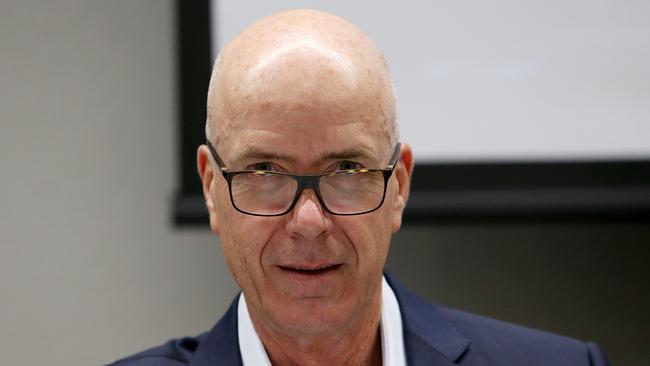Missteps on road to Fairfax merger
It’s unfair to blame Fairfax’s woes on Greg Hywood, who tried to do his best in a hostile environment.

Last week’s departure of Fairfax Media from ASX listings marked the formal end of the 177-year-old Fairfax publishing business.
The sale of the company’s main mastheads — The Sydney Morning Herald, The Age and The Australian Financial Review — as well as regional media assets, the Domain property websites and associated property magazines and its half share in the Stan streaming service to the Nine Network was marked with a favourable profile of chief executive Greg Hywood, 64, in the AFR last Saturday week.
But how good is the deal and can Hywood’s time in the top job be seen as a success? Given the history of mismanagement before Hywood’s arrival as CEO in 2010 — after being sacked from the company and given a multimillion-dollar redundancy in 2003 — the former editor-in-chief and publisher of the SMH, The Age and AFR has done better than many market watchers expected, even if he has disappointed Fairfax’s journalists.
Since the ill-fated privatisation of the company by the then 26-year-old Warwick Fairfax in 1987 and its collapse in 1990, Fairfax has been in a constant state of management flux. Pamela Williams, in her 2013 book Killing Fairfax, says the real rot set in when a professor of management theory and former dean of the Australian Graduate School of Management, Fred Hilmer, took the reins as CEO in 1998.
For media students who have not read it, Hilmer’s book of his time at Fairfax is a classic, and not in a good way. The Fairfax Experience: What the Management Texts Didn’t Teach Me goes the full monty on Fred’s lack of a newspaper reading habit and his thoughts about journalism, journalists and news stories as content modules. It was Fred who decided senior executives had to shift jobs regularly and he who moved successful AFR and SMH editor-in-chief Hywood to The Age in Melbourne.
It was also Fred who sacked Hywood, at least partly over problems with the introduction of the Tullamarine print plant that Hywood later closed as CEO. In a career replete with many such ironies, Hywood returned to Fairfax’s board in 2010 and joined then chairman Roger Corbett in voting to sack then CEO Brian McCarthy late that year.
And it was Fred who rejected Hywood’s entreaties that the company focus more of its investment in the papers’ digital offerings, including classifieds. Fred was emulating city-based information websites such as Boston.com. In 1999 Fairfax launched as part of its $100 million F2 division CitySearch, later sold to Telstra for $20m.
Hilmer also rejected efforts by then commercial director Alan Revell, a former editor of The Sun-Herald and editor-in-chief of SMH and former deputy to me at The Courier-Mail, to acquire a stake in the employment recruitment pure play Seek.
Time proved Revell right and the likely price, probably less than $40m, would have guaranteed a successful future for Fairfax. James Packer ended up with the Seek stake and News Limited was boosted by Lachlan Murdoch’s successful investment in the country’s now dominant real estate player, realestate.com.au.
Hilmer left in November 2005, to be replaced by David Kirk, former All Blacks rugby union captain.
So Hywood’s return to Fairfax followed a period in which the company missed many opportunities. But it also came at a difficult time for all media in the wake of the economic slowdown triggered by the global financial crisis. In print the digital pure plays had been tearing the heart out of Fairfax’s classifieds, the so-called “rivers of gold”.
He did what CEOs at this company did and called in management consultants. At News it was Boston Consulting and at Fairfax it was Bain & Company. The result was the June 2012 Fairfax of the Future plan that mapped out 1900 redundancies, reduced the broadsheet Age and SMH to tabloid, shut the Sydney and Melbourne state-of-the-art print sites, introduced paid digital subscriptions at the city-based papers and sent their subediting work offshore to New Zealand.
Fairfax also sold its successful Stayz holiday accommodation business for $220m and its NZ Trade Me website, acquired under Kirk in 2006, for $776m. Max Mason wrote in the AFR last Saturday week that “in 2012 Fairfax’s market capitalisation slumped to $847m. Factoring in the 40 per cent of Domain it gave to shareholders it is worth a little over $2 billion today”.
Given last year’s float of close Hywood mate Anthony Catalano’s Domain division and two failed beauty pageants orchestrated by Fairfax for US private equity players TPG and Hellman and Friedman, the Nine deal was probably the only thing going.
Yet it is not clear the business had to be sold off, or that the merged entity is any less vulnerable to digital disruption, particularly the damage being done to the advertising market by Facebook and Google, than the individual entities were.
The terms of the deal, 0.3627 Nine shares and 2.5c cash for each Fairfax share, implied a 22 per cent premium for Fairfax holders when the deal was announced. The situation has become murky since then with the softening sharemarket and a downgrade of Domain’s earnings guidance. But Fairfax chairman Nick Falloon was right to say the deal was “compelling for shareholders regardless of the share price change”.
For the staff, reassurances by Hywood, who will leave the business, and Nine CEO Hugh Marks, who will run it, are not worth a cracker. Nine will want synergies in editorial.
It is also unlikely to be as forgiving as Hywood of the continued editorial sniping at the SMH against Macquarie Broadcasting’s 55 per cent-owned subsidiary 2GB’s Alan Jones and Ray Hadley, which continued after Fairfax merged its radio assets with Macquarie in 2014.
While the larger regional Fairfax titles might produce editorial synergies I can’t see the smaller ones being of long-term interest to Nine. News-generating cost savings will be available from synergies between the Age and SMH operations and Nine’s television and online services.
The merged group could try to sell the AFR. It is arguably the country’s most successful newspaper commercially right now after two years during which editor-in-chief Michael Stutchbury has engineered dramatic digital subscription rises. The strength of its hard paywall, like that of The Australian when it introduced paid online subscriptions in 2012, highlights one of Hywood’s mistakes. The Age and SMH paywalls are so porous it is easy to obtain Fairfax content online without subscribing.
Yet it is digital subscription revenue, increased print cover prices and maintenance of print display revenue that are behind the success of papers such as The Australian and the AFR. The digital ad revenue rates Fairfax was counting on at The Age and SMH are plummeting as digital ad inventory increases exponentially.
Hywood also was forced by poor quality assurance and exchange rate changes to bring Fairfax’s subediting operation back from NZ and has backflipped on a stated intention to close his metropolitan print titles midweek. He had to recognise the value of unique business content to subscriber growth and unwind the merger between the metro’s business title Business Day and the AFR’s premium content.
Print remains a valuable source of revenue at this company and since, according to a report in the AFR in May, digital accounts for 39 per cent of Fairfax’s revenue, print must remain valuable to Fairfax. Hywood’s implied talking down of print during his first five years in the job was a mistake, shaking the faith of traditional print advertisers.
As Rupert Murdoch says in Williams’s Killing Fairfax, “I think Fairfax have damaged themselves with this public outspokenness about their problems … They’ve done a lot to destroy everybody’s revenue by talking about the future of print, publicly, time and again.”
Hywood’s greatest growth achievements will end up being his support of Domain’s Catalano and the investment in video-on- demand venture Stan. Despite journalistic carping about his Maserati and CEO salary — neither of which was out of whack for a major listed company CEO — the tough financial decisions he took were essential to the survival of Fairfax’s journalism.




To join the conversation, please log in. Don't have an account? Register
Join the conversation, you are commenting as Logout